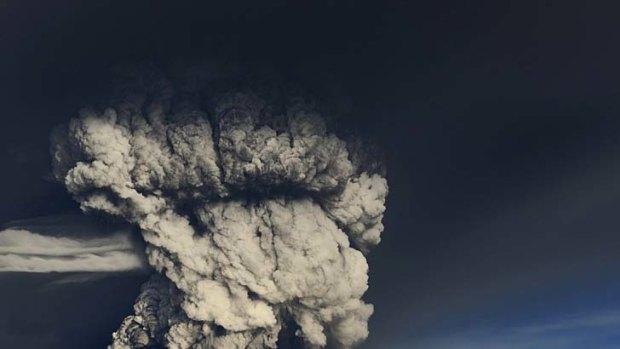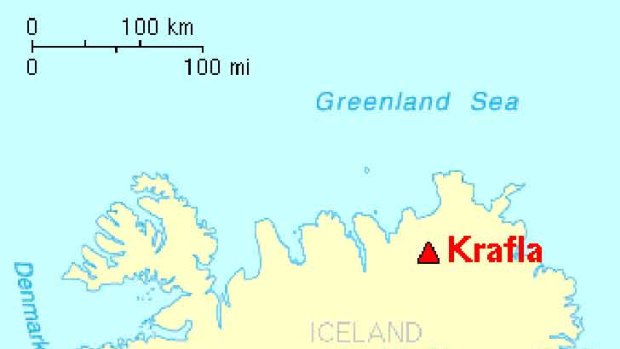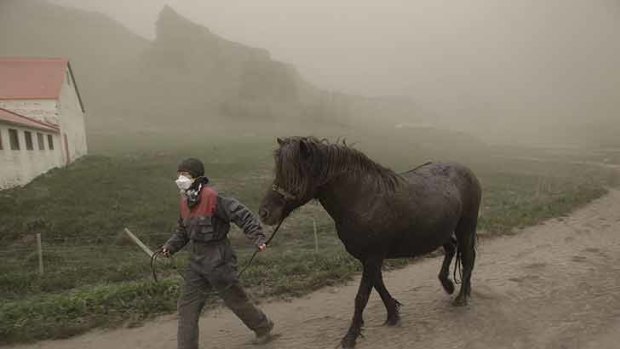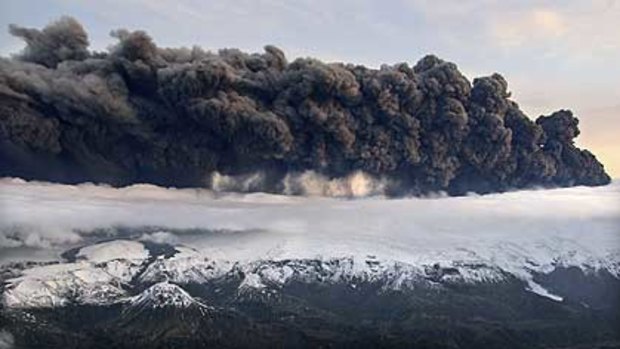By Glenda Kwek
Iceland may be heaven for vulcanologists, but to air travellers, it's just a load of ash, delay and tongue-twisting names.
One year after a volcano under the Eyjafjallajokull glacier erupted, sending plumes of ash kilometres into the atmosphere and severely disrupting air travel, the Harry Potter-sounding Grimsvotn volcano is threatening to wreak just as much havoc.

Up close ... a plane flies past a plume of ash from the eruption of the Grimsvotn volcano.Credit: Reuters
The ash has so far spread from Iceland, located north of Britain in the North Atlantic Ocean, with flights cancelled in northern Britain.
---------------------------------------

A map of some of the major volcanoes in Iceland, courtesy of the US Geological Survey.
Pronunciation guide:
Eyjafjallajokull - Aye-ya-fyah-dla jow-kudl
Grimsvotn - GREEMSH-votn
---------------------------------------

Local residents affected ... Anna Hardadottir, a farmer of Horgsland, leads a horse, through the ash pouring out of the erupting Grimsvotn volcano.Credit: AFP
Grimsvotn is Iceland's most active volcano, with nine eruptions between 1922 and 2004. But this month's eruption under the Vatnajoekull glacier in the south-east of the country is the most powerful in more than a century, vulcanologists told Agence France-Presse.
So why are there so many volcanoes in Iceland, and why are they so disruptive?

The Eyjafjallajokull glacier ... Smoke and steam hangs over the volcano under the glacier in Iceland last year.Credit: AP
Iceland is located on the mid-Atlantic ridge system, where the Eurasian and North American continental plates move apart, and was formed from the molten rock that rose from the sea floor about 20 million years ago.
"The mid-Atlantic ridge system, as the name implies, is a major ridge up to the middle area of the Atlantic where there are major volcanic eruptions regularly. But most of them are in deep marine water so we don't see them and it doesn't affect us," vulcanologist Paul Carr from the University of Wollongong said.
"Iceland is also on what's called a hotspot, that's an area of the earth where there's a lot of volcanic activity."
Iceland - about 1½ times the size of Tasmania and with a population of about 319,000 - has 35 active volcanoes.
When the volcanoes erupt, the interaction between the molten rock and the ice and snow that covers the island is destructive.
"When you have molten rock often at 1100 to 1200 degrees centigrade coming into contact with that you do get a lot of explosions, so you get these quite powerful eruptions," Associate Professor Carr said.
"What that does is fragment a lot of the volcanic material so you get lots of ash material, [and] so you get these enormous plumes or clouds of ash, which cause enormous problems for air traffic.
"If it was way out in the Atlantic it would not be a problem. [But] because it is so close to Europe and on the main air traffic routes it causes a major issue for them."
Besides Grimsvotn, there are the "Angry Sisters" Katla and Hekla.
Hekla, Iceland's best-known volcano and also its most active, last erupted in 2000, while Katla has an average of two eruptions each century, Iceland's Institute of Earth Sciences said.
Oraefajokull, the country's highest mountain at 2110 metres, is also its largest active volcano. It last erupted in 1727.
Bardarbunga, which like Oraefajokull and Grimsvotn is also located under the Vatnajoekull glacier, last erupted in 1903.
Closer to home, Indonesia, which lies on the "Pacific Ring of Fire" - an area around the Pacific Ocean where earthquakes and volcanic activity frequently occur - is home to 69 volcanoes.
Mount Merapi in central Java is one of the world's most active and deadly volcanoes and caused the deaths of more than 350 people during a series of eruptions in October and November last year.
But Associate Professor Carr said that, while such eruptions in Indonesia could affect flights in and out of Australia in a similar manner to the Icelandic eruptions, there were less concerns about their impact.
"From the world point of view, our population is relatively small and therefore the number of flights is much, much lower than there is in and out of Europe.
"[The flights] can get around them by flying away from the particular area where it is erupting."
- with agencies
Follow this reporter on Twitter @curious_scribe
Some other volcanoes that are erupting - or have erupted recently - around the world, excluding undersea mountains (text by AFP):
- Piton de la Fournaise, Reunion Island, Indian Ocean:
Erupts two or three times a year, most recently in December 2010. One of the world's most active volcanoes.
- Nyamuragira, Democratic Republic of the Congo:
Currently the most active of several major volcanoes on the African continent. Last erupted in January 2010.
- La Soufriere, Montserrat Island, British Caribbean:
A major eruption in 1997 wiped the island's small capital off the map; the most recent outbreak was in February 2010.
- Etna, Italy:
The highest active volcano in Europe. Last erupted in 2008.
- Pinatubo, the Philippines:
One of several active volcanoes in the country; it killed more than 800 people and displaced thousands when it suddenly erupted in 1991.
- Mount St Helens, north-western United States:
A gigantic eruption in 1980 removed the mountain's summit and sent a massive plume of dust into the stratosphere. Fifty-seven people died.
- Kilauea, Hawaii, United States:
One of the world's most active volcanoes, which has become a tourist attraction. Has been erupting regularly since the 1950s.
- Popocatepetl, Mexico:
Regularly active since 1994.